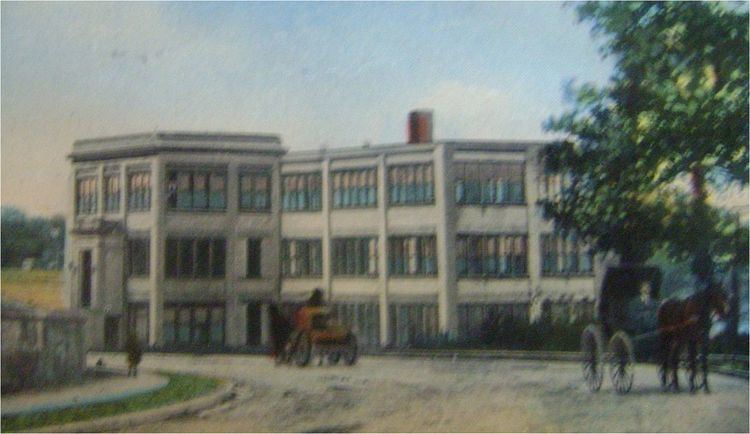Industry Watch manufacturer Defunct 1912 (1912) Founded 1909 Ceased operations 1912 | Fate Dissolved Headquarters Manistee Number of employees 90 Parent organization Star Watch Case Company | |
 | ||
Key people William Rath; Joseph Bachner Products Pocket watch mechanisms | ||
Manistee watch company
Manistee Watch Company was a watch manufacturing company that produced pocket watch mechanisms from 1909 until 1912.
Contents
History
The Manistee Watch Company made low quality watch mechanisms that were put into cases by other companies. The watches were in 16 and 18 size. The company name was emblazoned on the back plate of most 18 size movements. Some 16 size movements were jeweled. The dials, jewels, and hairsprings for the mechanisms were purchased from European watch manufacturers, but all other parts aside from the outside case were produced at the Manistee Watch factory. Most of the jewels for the watches were from heliotrope garnet and manufactured specifically to the correct dimensions for the Manistee watches in Switzerland. The first watches made sold for five dollars each.
Joseph M. Bachner (1853–1929), an inventor born in Alsace, France, designed the movements for low cost production to compete with the other inexpensive watches on the market. He also designed and constructed many of the specialized one-of-a-kind machines needed to make the watch parts. The mechanisms produced by the Manistee Watch Company factory were shipped to Ludington about 30 miles away and put into cases made by the Star Watch Case Company where Bachner previously worked.
Bachner partnered with William Rath in 1905–06 to enter into a contract with Manistee city officials to build a manufacturing plant there. The city put up a portion of a $50,000 bond issue to help construct the brick-built watch factory on park land adjacent to Manistee Lake at 123 Arthur Street. The three-story factory was built in 1908 and started watch production in March 1909. The first watch movements were 18 size and had 7 jewels. Rath was the president of the new company and Bachner was its general manager. Other directors of the factory were F.A. Bingham, Thomas J. Ramsdell, and Patrick Noud. The first floor housed the presses, drills, and lathes that formed the small watch parts and the second floor had the machines used by the employees to assemble the watch mechanisms. The third floor employees carried out assembly line inspections and any final assembly work that was required including adjusting. At the peak of production in 1909 there were 90 employees making 100 mechanisms per day. The factory put out 5 grades of watch movements, being 5 jewels, 7 jewels, 15 jewels, 17 jewels, and 21 jewels.
Rath was a business associate of Warren Cartier. Cartier was the secretary of the Star Watch Case Company in nearby Ludington, and because of this relationship the companies worked in partnership. The Manistee Watch Company factory looked identical to the Star Watch Case Company which was built in Ludington in 1906. The factory building was made with no wood except the window frames. It produced its own electricity that ran all the electric motors throughout the plant facilities. The main building was constructed with reinforced concrete of the Kahn System invented and patented by Julius Kahn in 1902. The factory was placed in a location where a dust free environment was given priority.
Disagreements arose between Rath and Bachner as to how the Manistee Watch Company should be run. Rath bought out Bachner's share of the business in a payment contract in 1910. The sales of the watches had slowed and there were insufficient funds for Rath to make his required payments to Bachner. In July 1911 Bachner sued Rath in federal court and the company was forced into bankruptcy and had to close. Additional funds were raised in August to reopen the factory. The company ultimately ceased production and permanently closed in 1912. The Manistee Watch Company had produced 60,000 pocket watches during its three-year existence. Business people from Chicago bought the machinery for $3,800 at an auction on August 6, 1912. The land and the factory building (which were valued at $30,000) were sold for $5,300. The old watch factory became the home of A.D. Joslin Manufacturing Company in 1917.
Legacy
There are less than fifty pocket watches known to exist in the United States of those produced by the Manistee Watch Company. The Henry Ford Museum has one in their collection that was made around 1910 that is 17 jeweled.
The Manistee watch was the first time a non-magnetic hairspring was made for a pocket watch in the United States. The hairspring was made of an alloy that did not involve a ferrous material that otherwise would be magnetic. The alloy was as strong as and had a life expectancy similar to steel, but contained no steel. The economical alloy was gold in color.
The name "Manistee Watch Company" is on file in Manistee as being owned by 2 businessmen, however no watches have been made by them.
